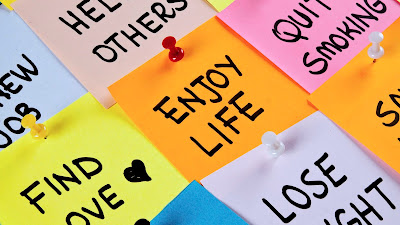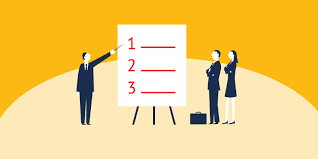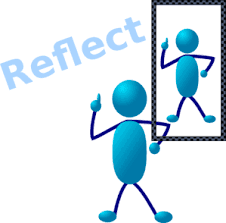Fact:
Each one of us has immense potential lying dormant within us.
 Why "realising our potential" is important ?
Why "realising our potential" is important ? -
Because only then we can accomplish our dreams and achieve more
How can we "realise our potential" that lies dormant in us (most of the time) ? - By building discipline and consistency in our actions. In other words, by building right kind of "Habits".
So, it's the right kind of habits that differentiates "mediocre" from "exceptional". Here, in this post, i mention about 5 habits that can help us create our BEST and catapult us to new levels of success and happiness. So, here i go sharing about those 5 key habits
Habit Number 1: Wake up Early
This is perhaps the most talked about habit of recent times. There are plenty of books and articles available on the subject of getting up early to utilise the "golden hours" and these books and articles explain in detail/depth about the numerous benefits of getting up early. I would reiterate the need by mentioning the following two quotes
"Wake up early every day so that while others are still dreaming, you can make your dreams come true" - Hal Elrod
"Lose an hour in the morning and you will be all day hunting for it" - Richard Whately
Talking about people who are productive and successful, they tend to always accomplish more than the rest. Ever wondered, how they are able to do that when each one of us have the same 24 hours at our disposal. The answer is simple - they realise the importance of the "golden hours" that exists in the morning, when the distractions are none/few, energy is at its peak, focus is high and then go about utilising those precious hours on doing something productive that can make a huge positive difference to our lives. So, imbibing the habit of waking up early gives us extra hour(s) that can turnaround our lives for better and help us accomplish more.
Important Benefit From This Habit : A positive, progressive and optimistic start to the day
Tips to get started :
- Initially, we should avoid being overambitious in setting the "wake-up" time. Set reasonable and realistic goals, which could be like getting up half-an-hour earlier than the current time and then gradually increase it.
- Don't hesitate to use a tool/ gadget / strategy to help you build this habit. It could be an alarm clock coupled with the 5-second rule (Read Related Article : Productivity in a matter of (5) seconds )
- Build in a positive motivation to feel excited about getting up early
- Work out an agenda for how you would utilise the "early hours". A simple strategy for this could be to utilise the early hours to work on the most important area(s) of your life. You may use the Wheel of Life for the purpose (Read Related Article: Wheel of Life )
Habit Number 2: Plan, Prepare and build Priority
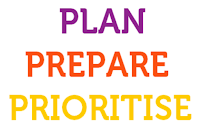
We may let go of the advantage of "golden hours" if we don't build a structure for our day/ life.
When we work, there are two types of FLOW we may engage in - one is where we could just spend our hours, days, months, years and ultimately our life in just going along with the "flow" of things around us, which, in the end, still leave us with feelings on incomplete and unaccomplished whereas the second type of FLOW is when we immerse ourselves in the task at hand because of the passion we have for the work/ task. This type of flow is all about harmony then and this creates balance in our life. Our quest in life is always about the second type of FLOW, where we get completely immersed in the task. So, once we have the right goal(s) identified for ourself, then it's only about the right structure/ framework to ensure that we are in right kind of "flow". This structure comprises of 3 Ps which are Plan, Prepare and Priority and these help us to identify (More and in-depth about the 3 Ps to be covered in a different post)
- what needs to be worked on i.e. the tasks/ activities/ goals aligned with purpose of life (Plan)
- resources required for the identified tasks and these resources could be skills, knowledge, expertise, and related (Prepare). A SWOT Analysis could be very helpful in this. (Read Related Article : SWOT Matrix - Know Yourself First )
- sequence to approach the tasks which refer to identifying the ones which are most important and will have the maximum impact on our life in that period of time
Few quotes that highlight the importance of 3 Ps are mentioned below:
"Failing to plan is planning to Fail" - Alan Lakein
"It's not the will to win that matters - everyone has that. It's the will to prepare to win that matters" - Paul "Bear" Bryant
"Good things happen when you set your priorities straight" - Scott Caan
Important Benefit From This Habit : Better productivity by focusing on the "right" tasks
Tips to get started
- Identify the list of all tasks to be worked upon. You may use the Brain Dump rule (Read Related Article: Brain Dump - Declogging a Cluttered Mind)
- Put the list in a visual form (written on paper or digital note pad)
- Capture the status quo to understand the current capabilities or identify the available resources (Read Related Article: SWOT Matrix - Know Yourself First )
- Identify tasks that need to be focused on earlier than the rest
Habit Number 3: Read/ Read More

Again, there are plenty of books and articles on the benefits of reading (you may also refer to my post
Why Read Books ? ). So, all that i would highlight here is the fact that reading opens up our mental faculties and renders us more creative and comprehensive in our approach towards life. There's a wholeness aspect that reading brings to our personality by way of building up connected knowledge and multiple perspectives about things, people, circumstances and situations. All this helps us deal with the uncertainties and unpredictability of life in a more wiser and rational way, which otherwise, we may never be able to learn experientially in real life, and if we somehow manage to learn, might take many years of our life. So, Reading is the way to go if we want flexibility, freedom and comprehensiveness to become integral to our way (attitude) of approaching life.
on the benefits of reading -
"To acquire the habit of reading is to construct for yourself a refuge from almost all the miseries of life" - W. Somerset Maugham
"Today a Reader, Tomorrow a Leader" - Margaret Fuller
"The man who doesn't read good books has no advantage over the man who can't read" - Mark Twain
Important Benefit From This Habit : A well-read person has a well-rounded personality and better equipped to deal with difficult situations.
Tip to get started:
- Start with anything short and easy-to-read types from your favorite genre
- After an easy start, move on to reading deeper books from the favourite genre
- Explore different genres
- Engage in reading multiple books (from different genre) simultaneously to build connected knowledge
Habit Number 4 : Connect (More)
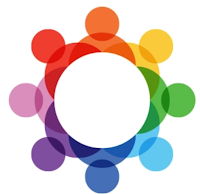
We live in an interconnected or rather a hyperconnected world where individual success is an outcome of mutual success. Just like the internet, considered to be an information superhighway, where utilising the power of hyperlinking, we hop from one piece of information/ knowledge to another and ultimately manage to fulfill our quest, likewise is the case with us in real life too. The social media and the virtual world has indeed bridged the gap among people and anyone could connect with anybody else in just a matter of few clicks. A testimony to this is the reducing "degrees of separation (a measure of social distance between people)", which is now even far below the normal six degree needed for any person to establish connection with anyone else in the world (irrespective of the geographical boundaries). We really need to ask ourselves, whether we are harnessing the power of connections. Remember, the more we connect, the more we open opportunities and avenues to collaborate. In this world of super-specialisation, multiple brains are needed to accomplish things. Here, "quality rules quantity", which means more connections may not always result in more success. It's always about the "quality of connections". So, take time out not just to connect but also to communicate with whom you already are connected. It's time to take that leap from Connection to Collaboration. Here's a wonderful quote highlighting the importance of Connection
"In a world of algorithms, hashtags and followers, know the true importance of human connection" - Unknown
Important Benefit From This Habit: Develops a "likeability" factor and a "doer" attitude because of the rapport with others
Tips to get started:
- Identify and establish your need for "Connecting" and "Collaborating"
- Be present and visible on relevant social media platforms
- Start conversation with relevant "connections" to build synergy
- Every now and then filter your list of connections (Remember - "Quality" matters over "Quantity")
Habit Number 5: Listen

In a world that's hungry for attention, whether online or offline (real-life), falling prey to "always be visible" trap is very common and easy. There's a rat race on social media about the "likes" and "views" and this has given birth to the "Talk More, Listen Less" syndrome. Somehow, the virtual world/ social media has misled us in believing that the more we talk, the more we will gain and this has only made the matters worse because now everyone seems to be in a hurry to only talk and share on social media. This attitude has permeated in our real world too and resulted in us losing grip on communicating effectively. We need to remember that listening is the most effective form of communication because it helps in achieving the "win-win" situation far better than any other means. Today, Listening is the most desired skill because we live in a world that's getting devoid of emotions/ empathy. The more we are connecting (virtually), the less connected (real world) we are becoming. The power of Listening could be gauged from the fact that it helps us across a range of areas where "communication" holds the key success. Few examples are establishing better relationships whether in personal or professional life, conflict resolution among team members, business partners or between spouses, conducting agenda-driven and result-seeking meetings, building trust among people, displaying empathy when it matters most, facilitating a counselling, therapy or coaching session, or simply when you happen to be a panelist or a speaker during a forum. So, living in a world where communication and collaboration have by-passed boundaries (physical, cultural, generational, etc.) and made working together quite challenging, listening could lay the right foundation for us to build trust and intimacy, and make relationships flourish. A couple of wonderful quotes on listening are mentioned below:
"You learn when you listen. You earn when you listen - not just money, but respect" - Harvey Mackay
"The quieter you become, the more you can hear" - Anonymous
Important Benefit From This Habit: Develops ability to be a "people person" and easily earn trust of others. Helps become a better influencer and get things done fast.
Tips to get started :
- Treat every conversation as an opportunity to learn and an addition to your knowledge
- Never operate from an "ego zone" during conversation as this will never let us listen to anyone
- Listening is a good antidote to anxiety and stress. So, be patient and wait for your turn to speak
- When listening, try and listen to the underlying emotions of the person in front of you (talking to you) and this will build deeper and stronger bond/ relationships.
So, imbibe these 5 habits and keep climbing the ladder of success !
N.B. : The images used in this post are sourced from internet
 Isn't it the case that in full excitement, so many of us set numerous goals during the onset of new year but only to find ourselves lose steam while pursuing them, during the course of the year, and ultimately ending in agony at having missed accomplishing the goals we set out to achieve ?
Isn't it the case that in full excitement, so many of us set numerous goals during the onset of new year but only to find ourselves lose steam while pursuing them, during the course of the year, and ultimately ending in agony at having missed accomplishing the goals we set out to achieve ? This is the first and foremost thing to to addressed and getting it right will set the tone for the rest of the 2 steps. How would it feel to see our effort and energy go waste just because we spent it on the "wrong" thing ? It is definitely not a great feeling and plays heavily on our mind and body because a good amount of our emotion, energy and time got consumed on something that did not yield any returns for us. So, is there a way to identify and establish goals that ensure progression for us ? Surely, there is a way and it is quite simple. A quick recall of our passion and purpose could set the ball rolling for us in terms of identifying the appropriate goals. Each one of us are passionate about something and live with a bigger purpose in life, something that gets ingrained in us and become a part of our DNA (not literally). For living that big purpose in life require us to identify some practical milestones and these milestones get referred to as goals. So, whenever in doubt about identifying and establishing appropriate goals, think about what milestones would help you live the purpose of your life. Believe me, this could help us come up with plenty of relevant goals and then it's our discretion to pick the ones that matter most in the given context. For example, if my purpose in life is to be an enabler and empowerer of people, then my identified goals would be around Life Coaching, Training, Counselling and Blogging. Basis my SWOT Analysis, i could identify and establish few goals to focus on.
This is the first and foremost thing to to addressed and getting it right will set the tone for the rest of the 2 steps. How would it feel to see our effort and energy go waste just because we spent it on the "wrong" thing ? It is definitely not a great feeling and plays heavily on our mind and body because a good amount of our emotion, energy and time got consumed on something that did not yield any returns for us. So, is there a way to identify and establish goals that ensure progression for us ? Surely, there is a way and it is quite simple. A quick recall of our passion and purpose could set the ball rolling for us in terms of identifying the appropriate goals. Each one of us are passionate about something and live with a bigger purpose in life, something that gets ingrained in us and become a part of our DNA (not literally). For living that big purpose in life require us to identify some practical milestones and these milestones get referred to as goals. So, whenever in doubt about identifying and establishing appropriate goals, think about what milestones would help you live the purpose of your life. Believe me, this could help us come up with plenty of relevant goals and then it's our discretion to pick the ones that matter most in the given context. For example, if my purpose in life is to be an enabler and empowerer of people, then my identified goals would be around Life Coaching, Training, Counselling and Blogging. Basis my SWOT Analysis, i could identify and establish few goals to focus on. more direct and specific we get about the returns/ benefits, the better would be our effort for accomplishing these identified goals. For example, if one of my identified goal is to get certification in Life Coaching, then this step is where i start defining the benefits of accomplishing that particular goal. Here, in this example, one of the key benefit might be adding an international credential to my portfolio and opening my offerings to global audience. Anywhere, close to 3 reasons per goal should be convincing enough for us to pursue that goal.
more direct and specific we get about the returns/ benefits, the better would be our effort for accomplishing these identified goals. For example, if one of my identified goal is to get certification in Life Coaching, then this step is where i start defining the benefits of accomplishing that particular goal. Here, in this example, one of the key benefit might be adding an international credential to my portfolio and opening my offerings to global audience. Anywhere, close to 3 reasons per goal should be convincing enough for us to pursue that goal. more direct and specific we get about the returns/ benefits, the better would be our effort for accomplishing these identified goals. For example, if one of my identified goal is to get certification in Life Coaching, then this step is where i start defining the benefits of accomplishing that particular goal. Here, in this example, one of the key benefit might be adding an international credential to my portfolio and opening my offerings to global audience. Anywhere, close to 3 reasons per goal should be convincing enough for us to pursue that goal.
more direct and specific we get about the returns/ benefits, the better would be our effort for accomplishing these identified goals. For example, if one of my identified goal is to get certification in Life Coaching, then this step is where i start defining the benefits of accomplishing that particular goal. Here, in this example, one of the key benefit might be adding an international credential to my portfolio and opening my offerings to global audience. Anywhere, close to 3 reasons per goal should be convincing enough for us to pursue that goal. This step is all about the Action Steps that we need to take for achieving the goals. Getting clear about the steps to take for accomplishing a particular goal makes it easy for us to take action. A goal may just remain a wish in the absence of action and so it becomes very important to identify the actions that will help us in fruition of goals. Anywhere around 5 action steps should be sufficient. Discussing the same example as above, few of the action items for the goal of "getting certified in life coaching" could be to research about the schools/ institutes offering the certification in terms of their validity, duration, fees, content, trainer, etc. Another step in the regard could be to connect with an existing coach to seek their opinion/ suggestion. Here also, SWOT Analysis could help in adopting a more realistic approach to identifying the appropriate action.
This step is all about the Action Steps that we need to take for achieving the goals. Getting clear about the steps to take for accomplishing a particular goal makes it easy for us to take action. A goal may just remain a wish in the absence of action and so it becomes very important to identify the actions that will help us in fruition of goals. Anywhere around 5 action steps should be sufficient. Discussing the same example as above, few of the action items for the goal of "getting certified in life coaching" could be to research about the schools/ institutes offering the certification in terms of their validity, duration, fees, content, trainer, etc. Another step in the regard could be to connect with an existing coach to seek their opinion/ suggestion. Here also, SWOT Analysis could help in adopting a more realistic approach to identifying the appropriate action.
